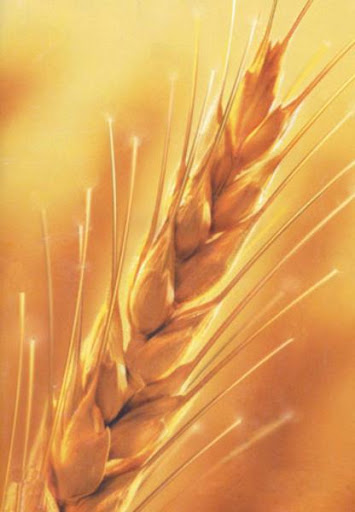Wednesday, February 9, 2011
China Wheat Drought May Last to Spring, Minister Says
 Feb. 10 (Bloomberg) -- China, the largest wheat consumer, says the drought in the country’s main growing region may be prolonged, as prices surge to a record.
Feb. 10 (Bloomberg) -- China, the largest wheat consumer, says the drought in the country’s main growing region may be prolonged, as prices surge to a record.
About 115.95 million mu (7.73 million hectares) of wheat, or 42 percent of the total planted in the eight major producing provinces, is affected by the dry spell that may last into the spring, Minister of Agriculture Han Changfu said in a statement on the department’s website yesterday.
Rain on the North China Plain has been “substantially” below-normal since October, the United Nations’ Food and Agriculture Organization said Feb. 8. Continued drought could force China, largely self-sufficient in wheat, to buy more grain from overseas suppliers, said Jason Britt, an analyst at Central States Commodities Inc.
“That sends a little bit of a shiver through the market,” Britt said by telephone from Kansas City, Missouri. China may import 1 million metric tons of wheat this year, compared with 9.8 million tons by Egypt, the top buyer, according to the U.S. Department of Agriculture.
Drought-affected provinces including Hebei, Shanxi, Henan, Shandong, Jiangsu and Anhui have received “precious snow” since yesterday which will help relieve some of the dryness, the National Meteorological Center said on its website. Rain and snow are forecast to continue today, it said.
‘One Big Rain’
Wheat futures jumped to 3,064 yuan ($465) a metric ton on the Zhengzhou Commodity Exchange today, a record for the most- active contract. The price on the Chicago Board of Trade, a global benchmark, was little changed at $8.8425 a bushel after jumping to $8.9325 a bushel yesterday, the highest since 2008.
Most crops in China’s wheat region are irrigated and only about 5 percent of the area’s annual precipitation normally falls in the December-February period, said Mike Tannura, a meteorologist at T-Storm Weather in Chicago.
“Even though it’s been dry relative to average, 95 percent of precipitation occurs from March through November,” Tannura said. “It’s a concern, no question about it, but one big rain in March and all of a sudden they’re back above average.”
Major wheat growing areas have received about 0.25 inch (0.6 centimeter) of precipitation since Dec. 1, about 20 percent of the usual amount, he said.
Food Costs
China pledged to spend an extra 6.7 billion yuan ($1 billion) to boost emergency water supply and irrigation resources, according to a government statement. This is in addition to 10 yuan per mu in direct subsidies to encourage farmers to water wheat, and another 10 yuan to fertilize weakened seedlings, it said.
Rising food costs have stoked inflation in emerging economies. The past month’s protests in North Africa and the Middle East were partly linked to food costs.
China’s consumer prices advanced 3.3 percent last year, breaching a government target of 3 percent. The January rate may have accelerated to 5.4 percent, according to the median estimate of 26 economists surveyed by Bloomberg, from 4.6 percent in December. Inflation in Indonesia, Southeast Asia’s biggest economy, was 7.02 percent last month, a 21-month high.
The People’s Bank of China on Feb. 8 raised the one-year lending rate by a quarter of a percentage point to 6.06 percent and the one-year deposit rate an equivalent amount to 3 percent.
Top Consumer
The provinces most affected by the drought are Shandong, Jiangsu, Henan, Hebei and Shanxi, representing 67 percent of the country’s wheat production in 2009, the FAO said. China has 14 million hectares (34.6 million acres) planted with winter wheat in those areas, of which about 5.16 million hectares may have been hurt, it said, citing government estimates.
China is the largest wheat consumer, representing about 17 percent of global usage in the year to June 30, the London-based International Grains Council predicts. The country’s wheat output may have dropped to 114.5 million tons at the last harvest from 115.1 million tons a year earlier, the USDA estimates. Macquarie Group Ltd. expects production to drop a further 4 million tons this year.
Premier Wen Jiabao visited Shandong last week during the Lunar New Year holiday to inspect conditions on the ground, according to the Xinhua News Agency. The country has to “prepare for the worst and do our best to combat the drought to ensure a good harvest,” Wen was cited as saying.
While the UN says global food prices climbed to a record in December, grain stockpiles have been replenished since 2007-2009, when the U.S. State Department estimates there were more than 60 food riots worldwide. Combined inventories of corn, wheat, rice and soybeans will end this year at 457.6 million tons, 21 percent more than in 2007, USDA estimates show.
China has abundant wheat stockpiles which will lessen the impact of the drought on supply, Li Qi, an analyst at Everbright Futures Co., wrote in a report. Inventories are the highest in seven years, Li said.

This post was written by: HaMienHoang (admin)
Click on PayPal buttons below to donate money to HaMienHoang:
Follow HaMienHoang on Twitter













0 Responses to “China Wheat Drought May Last to Spring, Minister Says”
Post a Comment